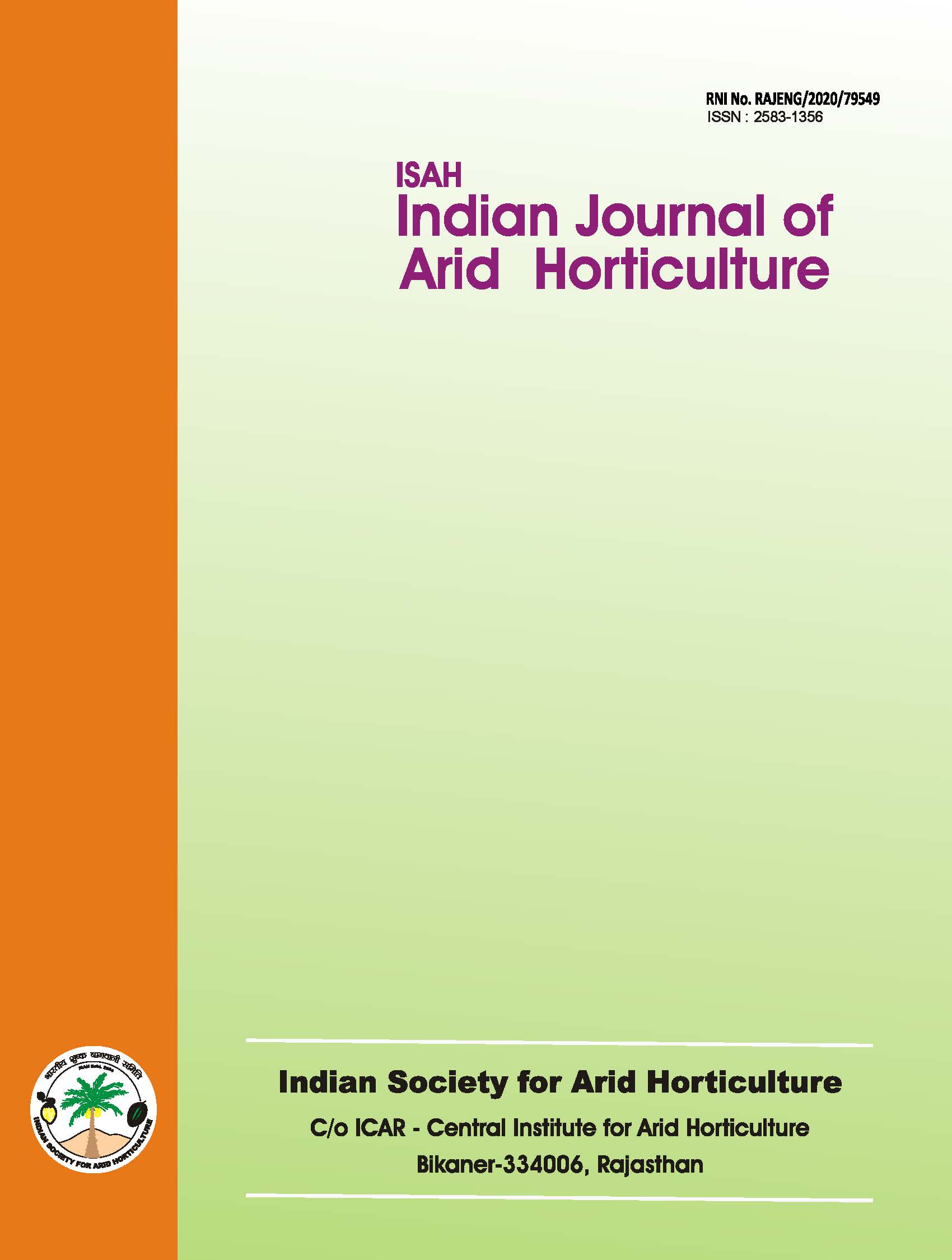Assess1nent of population of pseudomonads inhabitant of ton1ato plant rhizosphere for searching of potential antagonist of Fusarium udum
Keywords:
Fusarium udum, pseudomonads, tomatoAbstract
Eighl isola1cs of fluorescent pseudomonads were isolated from the disease suppressed and identified and characterized by physiological and biochemical and bac1eriological tests. LPK2 aligned to same clus1er (100% boois1rap value) with reference slrains of Pseudomonasjluorescens. All 1he strains of P.jluorescens LPK2 showed IAA production, phospha1e solubilisa1ion, siderophore production and HCN production. Chi1inase activity and P-1,3-glucanase activity was also pronounced in P. j/uorescens LPK2. In dual culture technique, all the slrains of Pseudomonas (LPK I lo LPK8) inhibiled the in vitro growth of F. udum. Maximum inhibition of F. udum recorded in the case of f'.f/uorescens LPK2. Cell free culture filtrale of also restricted lhe hyphal g,owth of F. udum. Scanning electron microscopic studies on morphological fcal~r~s in the hyphae of F. udum in lhe form of fragmentation and degradation of mycel ia and loss of structural integrity of conid,a of F. udum were clearly observed. In iron supplemented (3011M Fe'') medium inhibi1ion of the pathogenic fungi was reduced. Under iron-deficient condition, P.fluorescens LPK2 inhibited F. udwn by 65% The inhibition of the pathogen by P.f/uorescens LPK2 under iron-sufficienl conditions was 51%. ·Downloads
References
Nene, Y.L., Sheila, V.K., & Sharma, S.B. (1996). World list of chickpea and pigeon pea pathogens, seed. ICRISAT, Patancheru, India, pp. 27.
Pant, R., & Mukhopadhyay, A.N. (2001). Integrated management of seed and seedling root disease complex of soybean. Indian Phytopathology, 54, 346-350.
Ayala, S., & Rao, E.V.S.P. (2002). Perspective of soil fertility management with a focus on fertilizer use for crop productivity. Current Science, 82, 797-807.
Haas, D., & Keel, C. (2003). Regulation of antibiotic production in root-colonizing Pseudomonas spp. and relevance for biological control of plant diseases. Annual Review of Phytopathology, 41, 117-153.
Bhatia, S., Bhatia, S., Dubey, R.C., & Maheshwari, D.K. (2003). Antagonistic effect of fluorescent pseudomonads against Macrophomina phaseolina that causes charcoal rot of groundnut. Indian Journal of Experimental Biology, 41, 1442-1446.
Gupta, C.P., Dubey, R.C., & Maheshwari, D.K. (2002). Plant growth enhancement and suppression of Macrophomina phaseolina causing charcoal rot of peanut by fluorescent Pseudomonas. Biological Fertility of Soils, 35, 399-405.
Kamlesh Choure, Rakesh Bhargava, R.C. Dubey, & D.K. Maheshwari. (2009). Indian Journal of Arid Horticulture, 4(2), 82-94.
Dunne, C., Moenne-Loccoz, Y., McCarthy, J., Higgins, P., & Booth, C. (1971). The genus Fusarium. Commonwealth Mycological Institute, Kew, England.
Powell, J., Dowling, D.N., & O'Gara, F. (1998). Combining proteolytic and phloroglucinol-producing bacteria for improved biocontrol of Pythium-mediated damping-off of sugar beet. Plant Pathology, 41, 299-301.
Nelson, P.E. (1991). History of Fusarium systematics. Phytopathology, 81, 1045-1048.
Minton, B.F., & Garber, R.H. (1983). Controlling the seedling disease complex of cotton. Plant Disease, 61, 115-118.
Gupta, C.P., Sharma, A., Dubey, R.C., & Maheshwari, D.K. (2001). Antibiosis-mediated necrotrophic effect of Pseudomonas GRC against two fungal plant pathogens. Current Science, 81, 90-94.
Validov, S., Mavrodi, O., De La Fuente, L., & Boronin, A. (2005). Antagonistic activity among 2,4-diacetylphloroglucinol-producing fluorescent Pseudomonas spp. FEMS Microbiology Letters, 242, 249-256.
Kloepper, J.W., Hume, D.J., Scher, F.M., Singleton, C., Tipping, B., Laliberté, M., Frauley, K., Kutchaw, T., Simonson, C., Lifshitz, R., Zaleska, I., & Lee, L. (1988). Plant growth-promoting rhizobacteria (PGPR) on canola (Brassica napus). Plant Disease, 72, 42-46.
Lucy, M., Reed, E., & Glick, R. (2004). Application of free-living plant growth-promoting rhizobacteria. Antonie van Leeuwenhoek, 86, 1-25.
Kumar, B., Dubey, R.C., & Maheshwari, D.K. (2005). Biocontrol of Macrophomina phaseolina: Prospects and constraints. In: Satyanarayana, T., & Johri, B.N. (Eds.), Microbial diversity: Current perspectives and potential applications. I.K. International Pvt. Ltd., New Delhi, pp. 471-492.
Palleroni, N.J. (1984). Gram-negative aerobic rods and cocci, family Pseudomonadaceae. In: Krieg, N.R., & Holt, J.G. (Eds.), Bergey's Manual of Systematic Bacteriology, Vol. 1. William and Wilkins Co., Baltimore, Md., pp. 141-199.
Paulitz, T.C., & Loper, J.E. (1991). Lack of a role for fluorescent siderophore production in the biological control of Pythium damping-off of cucumber by a strain of Pseudomonas putida. Phytopathology, 81, 930-935.
Chabot, R., Beauchamp, C.E., Kloepper, J.W., & Antoun, H. (1998). Effect of phosphorus on root colonization and growth promotion of maize by bioluminescent mutants of phosphate-solubilizing Rhizobium leguminosarum bv. phaseoli. Soil Biology and Biochemistry, 30, 1615-1618.
Nautiyal, C.S. (2000). Biocontrol potential and its exploitation in sustainable agriculture. In: Upadhyay, R.K., Mukherji, K.G., & Chamola, B.P. (Eds.), Biocontrol in sustainable agriculture, Kluwer Academic/Plenum Publishers, New York, pp. 9-23.
Antoun, H., Beauchamp, C.J., Goussard, N., Chabot, R., & Lalinde, R. (1998). Potential of Rhizobium and Bradyrhizobium species as plant growth-promoting rhizobacteria on non-legumes: Effect on radishes (Raphanus sativus L.). Plant and Soil, 204, 57-67.

